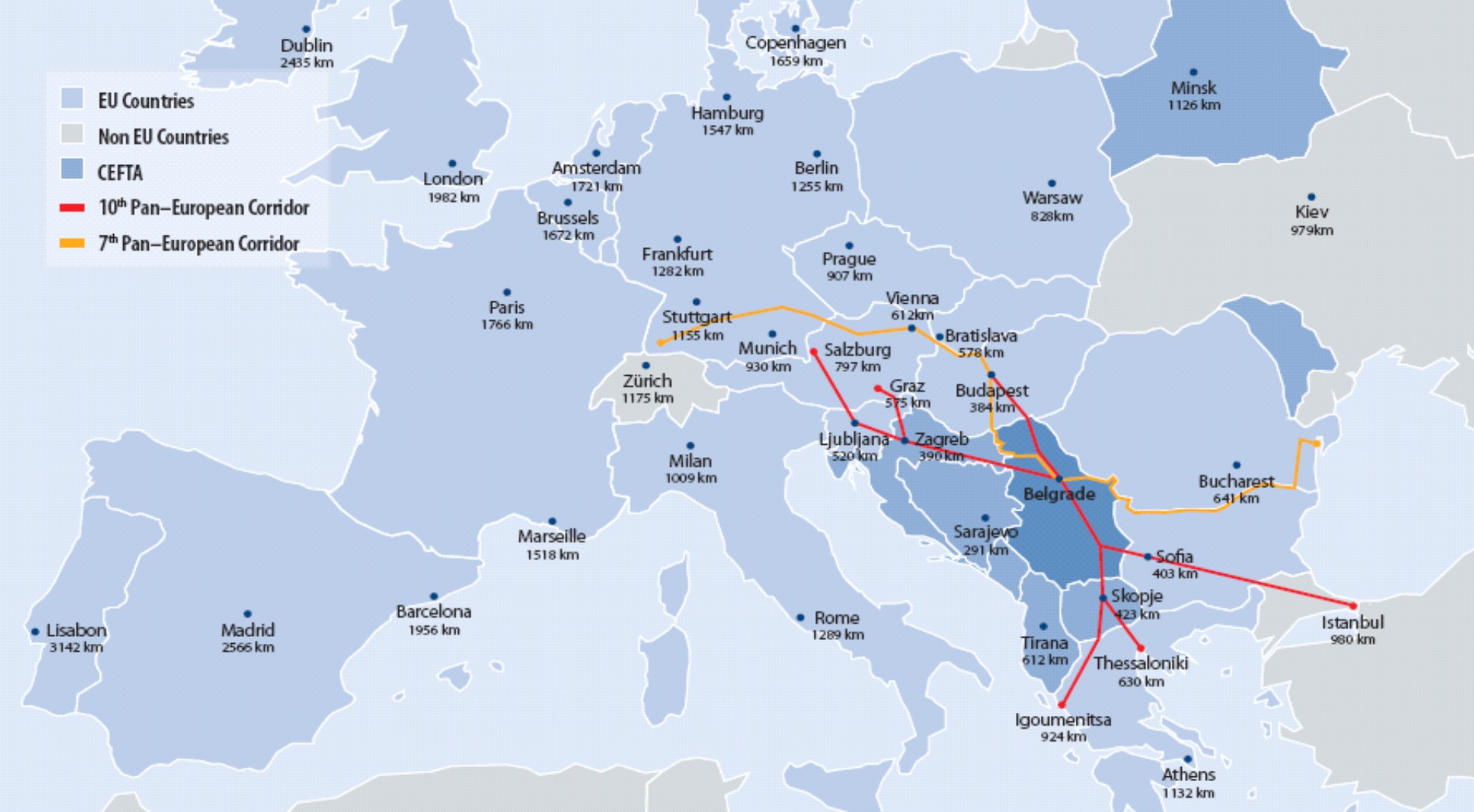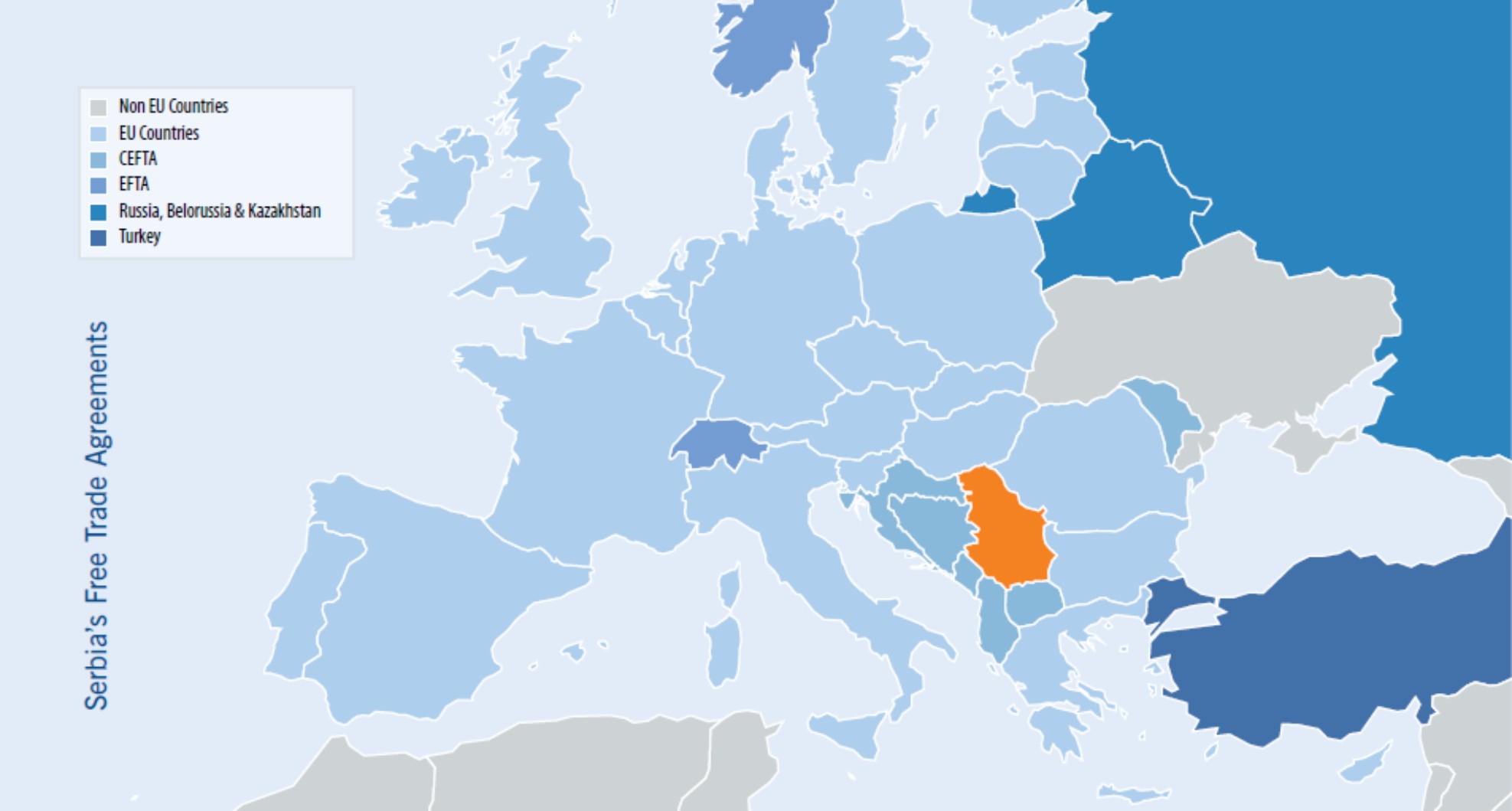|
Local Market and External Trade
For its position on the geographic borderline between the East and West, Serbia is often referred to as a gateway of Europe. In addition, two very important European corridors, No. 7 - River Danube and No. 10 - the international highway and railroad, intersect on the Serbian territory providing excellent logistic connections with Western Europe and the Middle East.

Source: SIEPA
South East Europe is the region with the highest growth rate in Europe, and among the fastest growing regions, globally.
Internally, with 7.5 million people, Serbian market is the 2nd largest market in South East Europe. The average net monthly salary rose from merely €190 in 2004 to €413 in 2012. Coupled with rapid consumer loan expansion, this fueled a sharp increase in local demand that was particularly reflected in a double-digit surge in retail trade turnover on an annual basis and dozens of new stores across the country opened up by international retail chains.
Export growth rates are one of the highest within the transition countries.
|
|
The external trade in 2012 noted the highest level with the countries Serbia had signed agreements on free trade. European Union member countries account for more than 50% of the total external trade (58.1%).
Serbia’s second major partner refers to the CEFTA countries, since our gained surplus in external trade amounted to USD 1318.4 million, resulting mainly from the exports of agricultural products (cereals and produces thereof and various sorts of drinks), as well as exports of iron and steel. Regarding imports, items mainly related to hard coal, coke and briquettes, iron and steel, electricity, as well as fruit and vegetables. Serbia’s exports to CEFTA countries in 2012 amounted to USD 2,861.0 million, while the imports were USD 1,542.6 million. The export– import ratio equaled 185.5 %.
According to the divisions of the Standard International Trade Classification (SITC) the following items had the greatest exports share: cereals and produces thereof (USD 838 million), electrical machines and apparatus (USD 831 million), non-ferrous metals (USD 673 million), road vehicles (USD 605 million) and fruit and vegetables (USD 539 million). These five sections accounted for 30.7% of the overall exports.
Free Trade Agreements
Externally, Serbia can serve as a manufacturing hub for customs-free exports to a market of over 1 billion people. It includes the European Union, the United States of America, Russia, South East Europe, Belarus, Kazakhstan, Turkey and EFTA members (Norway, Switzerland, Iceland, and Liechtenstein). This customs-free regime covers most key industrial products, with only a few exceptions and annual quotas for a limited number of goods.
Upon the completion of negotiations with Egypt, the territory with duty-free access for Serbia will be increased by additional 77 million consumers.

Source: SIEPA
European Union
Exports to the European Union market are free-of-customs according to the Stabilization and Association Agreement. For several food products (baby beef, sugar and wine) export quantities are limited by annual quotas. Imports from the EU are pursued based on the Interim Trade Agreement, as part of the Stabilization and Association Agreement, providing for progressive abolishment of import customs duties for industrial and certain agricultural products from the EU countries by 2014.
United States of America
Export to USA under Generalized System of Preferences (GSP) regime applies for approximately 4,650 products, including nearly all finished and semi-finished goods and selected agricultural and primary industrial products. Certain sensitive goods (e.g. most textile products, leather goods, and footwear) are not eligible for duty-free exports. The list of eligible goods is reviewed and adjusted twice per year, with input from U.S. industries.
For the full list of goods eligible for GSP treatment log on to: www.ustr.gov
Russian Federation
This FTA makes Serbia particularly attractive to foreign investors in the manufacturing sector. The Agreement stipulates that goods produced in Serbia, which have at least 51% value added in the country, are considered to be of the Serbian origin and thus exported to Russia customs free (the only tariff charged is the customs record keeping tariff, amounting to 1%). The FORM A Certificate is required as a proof of goods origin. The list of products, excluded from the Free Trade Agreement, is revised annually. As of March 2012, the list of excluded products comprises poultry and edible waste, some sorts of cheese, sugar, sparkling wine, ethyl-alcohol, tobacco, cotton yarn and fabrics, some types of compressors, tractors and new and used passenger cars.
The FTA with Russian Federation in full can be found here . |
|
Belarus
The Free Trade Agreement with Belarus envisages mutual abolishment of customs and non-customs duties in trade between the two countries. There are only a few exceptions to the Agreement, including sugar, alcohol, cigarettes, as well as used cars, buses, and tires.
Kazakhstan
This Free Trade Agreement was came into effect on January 1, 2011 and due to its positive effects Serbian goods attract more buyers not only from Kazakhstan, but also from the Russian Federation and Belarus, as well as potential investors who are interested in opening their production in Serbia. The FTA states that the parties will not charge customs duties, fees and charges with equivalent effect for products originating in one party and intended for the market of the other party. Exceptions were made for some products stated in the annexes and applicable rates are specified by national customs tariffs. For the rules of FTA to be applied, it is necessary to submit the original certificate determining the country of origin of the product (Form CT-2) to the Customs of the importing country.
Central European Free Trade Agreement (CEFTA)
The FTA between Albania, Bosnia and Herzegovina, Croatia, FYR Macedonia, Moldova, Montenegro, Serbia and the United Nations Interim Administration Mission (UNMIK) in Kosovo has been in effect as of July 2007, providing companies in Serbia with an opportunity to reach the 29 million people market free-of-customs. In addition, the Agreement stipulates accumulation of products origin, meaning that products exported from Serbia are considered of the Serbian origin if integrated materials originate from any other CEFTA country, the European Union, Iceland, Norway, Switzerland (including Liechtenstein) or Turkey, provided that such products have undergone sufficient processing (if the value added there is greater than the value of the materials used in Serbia). For exports to the member countries of CEFTA, the EUR 1 Certificate is required as a proof of goods origin.
Information about CEFTA Agreement can be found here .
Turkey
Industrial products originating in Serbia can be exported to Turkey without paying customs duties. Imports of industrial products into Serbia are generally customs-free, but for a large number of goods customs duties will be progressively abolished by the end of 2015. For trade in agricultural products customs duties remain in effect, with certain Most Favored Nation reductions for a number of products.
EFTA
Except for a very limited number of goods, including fish and other marine products industrial products exported from Serbia to EFTA member states (Switzerland, Norway, Iceland, and Liechtenstein) are exempted from paying customs duties. Customs duties for imports of industrial products originating in EFTA states will be gradually abolished by 2014. Trade in agricultural products is regulated by separate agreements with each of EFTA members, providing for mutual concessions for specified products.
The Agreement with EFTA member countries can be found here .
World Trade Organization (WTO)
WTO compliance negotiations are in the final stage. In the process of accession to the WTO Serbia finalized bilateral protocols with 13 WTO members by the end of 2012. In January 2013, the bilateral protocols on trade liberalization of goods and services with Mexico and the Republic of Panama were signed and negotiations with the Dominican Republic completed. Negotiations with India, Ukraine and Brazil are ongoing and the goal is to achieve the accession of the Republic of Serbia to the WTO in 2013.
|

